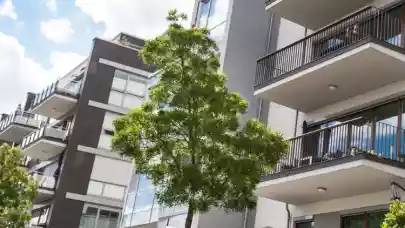
Europe’s fundamental mismatch between voracious housing demand and the limited supply is driving massive investment growth in the residential sector and will continue to generate opportunities even amid geopolitical and economic uncertainties, according to a new report by Colliers.
Colliers’ latest EMEA: European Living Snapshot finds that residential investment volumes surged 89% over the course of 2021, and for the first time crossed the 30% line as a proportion of real estate investment in Europe. Underlying this growth is what the report describes as “strategic levels of under-supply to meet urban household formation and growth.”
Luke Dawson, Managing Director Cross Border Capital Markets, commented, “Amid current economic volatility, this long-term imbalance makes the living sector attractive to capital seeking a defensive, contracyclical investment with a variety of routes to market. Build-to-rent (BtR), for example, is gaining in popularity due to the limited availability of existing stock, alongside investment into social and affordable housing.”
Another notable hotspot across much of Europe is purpose-built student accommodation (PBSA), particularly around universities with an international reputation that can attract students from near and far. “We’re seeing more activity concentrate on niche areas related to specific demographic factors,” said Damian Harrington, Head of Research, EMEA and Head of Global Capital Markets Research, “PBSA is attracting a lot of interest in markets like Italy, Spain and Central and Eastern Europe.”
One clear trend is that investor interest is expanding well beyond Europe’s largest and most famous urban areas, with lower-tier cities also seeing a notable uptick in activity in 2021. In this respect, the European market is beginning to mirror the US, where residential investment is increasingly targeting smaller cities such as Charleston, Tucson and San Antonio.
“The migration to tier-2 and -3 cities is increasingly evident in Europe’s more mature markets,” said Paddy Allen, National Capital Markets, UK at Colliers, “Places like Gothenburg and Manchester are attracting more attention as investors expand their search for yield.”
Report highlights
The range, scale and strategies for residential investment vary considerably across the globe. In Europe, the strongest growth markets have also been those benefiting from a significant share of residential investment. These include the Nordic cities of Stockholm, Malmo, Gothenburg and Copenhagen. Berlin tops the bill, Barcelona is a fast-moving market, with investment levels flourishing courtesy of an expanding residential sector, as are the likes of Madrid, Helsinki, Manchester and Dublin.
Czech market: Challenging situation
Czechia has always been strongly oriented to owner-occupation. This trend has softened a little in recent years, particularly in Prague, although the preference for private ownership is still very strong. The younger generation and foreign workers are the key drivers of demand for the private rental sector. Increasing house prices, which have skyrocketed over the past six years, have also been partly responsible for rising interest in the rental market as the sale prices of flats, new builds and second-hand assets have risen sharply.
Rental prices in Prague peaked in 2019 and declined slightly during the pandemic as a result of a lack of tourism. Apartments geared towards the short-stay/Airbnb market converted back to traditional leases, rebalancing the local supply and demand dynamics short-term. As of 2022, residential rents are rising back to pre-pandemic levels, but this has not impacted demand. Given the current mortgage rules and bank products available, many would-be buyers are disqualified before applying, further driving demand for rental accommodation.
On the supply-side, private rental accommodation has historically been serviced by individual owners and just a handful of professional landlords managing portfolios. Therefore, institutional investors targeting the private rental sector have an opportunity to catch and be amongst the first to set the rules and market standards.
The residential market in Czechia can be described as challenging for practically everybody who is active in the market and looking for an opportunity. Investors interested in entering the Czech market face a competitive market with a shortage of available projects for investment. The shortage is mainly due to the lengthy planning permit process, but also thanks to a number of active investors securing units in bulk in projects through forward purchases or forward funding. The complicated development process has led to bottlenecks in supply, with Prague currently undersupplied by tens of thousands of residential units. This is driving prices so high, that the yield from renting such apartments is not competitive versus other asset types and locations.
Polish market: Growing demand
Poland is at a nascent stage of development when it comes to the residential investment market, but we are observing exponential growth in new development and activity. The 7,500 BtR units now in circulation will be complemented by a further 23,000 BtR units under construction/in the permitting phase. This remains a drop in the ocean relative to Poland’s traditional rental market, which is mainly fragmented (owned by private individuals), but estimated to comprise 1.2 million units. This reflects the significant upside in BtR activity.
From an investment perspective, €0.6 bn was deployed in PRS asset acquisitions in 2021, primarily in forward purchase and joint ventures. Whilst this remains a limited share of the €6.3 bn invested across all sectors in 2021, it represents significant growth in activity when compared to previous years. These volumes also exclude a lot of M&A transactions among residential developers, including Echo Investment’s acquisition of Archicom, Tag Immobilien acquiring Vantage Development in 2019 and recently ROBYG at the end of 2021, and Cornerstone/Crestyl acquiring Budimex Nieruchomości. This consolidation points to a growing maturation of the market.
With rising interest rates and inflation alongside higher construction costs – both materials and labour – owning a flat is becoming less affordable than renting. This is driving rental demand, illustrated by a considerable fall of 20% in mortgage applications between December 2021-January 2022. Corporate expansion in Poland remains strong, and with a positive net migration rate demand for rental accommodation is also rising in tandem. Moreover, the development of BtR schemes in locations typically restricted to commercial use zoning is enabling new city living options in many attractive locations where residential units for sale are not available.
Another positive for the market is that yields for PRS/BtR units in Poland are trading higher than those available in more mature European destinations. However, the lack of ready-to-buy standing assets is a challenge for investors, with activity restricted to forward purchase/funding type transactions, joint ventures or M&A activity. However, we expect that as BtR platforms grow, this will generate a secondary trading market in years to come.



